Analysis of Labour Market Trends in the UK and Japan
VerifiedAdded on 2022/09/17
|17
|4821
|38
Homework Assignment
AI Summary
This assignment analyzes labor market trends in the UK and Japan, exploring factors such as wages, immigration, trade union membership, and unemployment. It assesses the significance of tight and loose labor markets and organizational strategies. The document further describes the roles of government, employers, and trade unions in ensuring future skills needs are met. It outlines principles of effective workforce planning and tools like 9-Box Grid. The assignment includes a succession and career development plan, detailing development goals, actions, and measurements. Finally, it provides evidence of the student's contribution to plans for downsizing an organization, emphasizing communication and fairness.
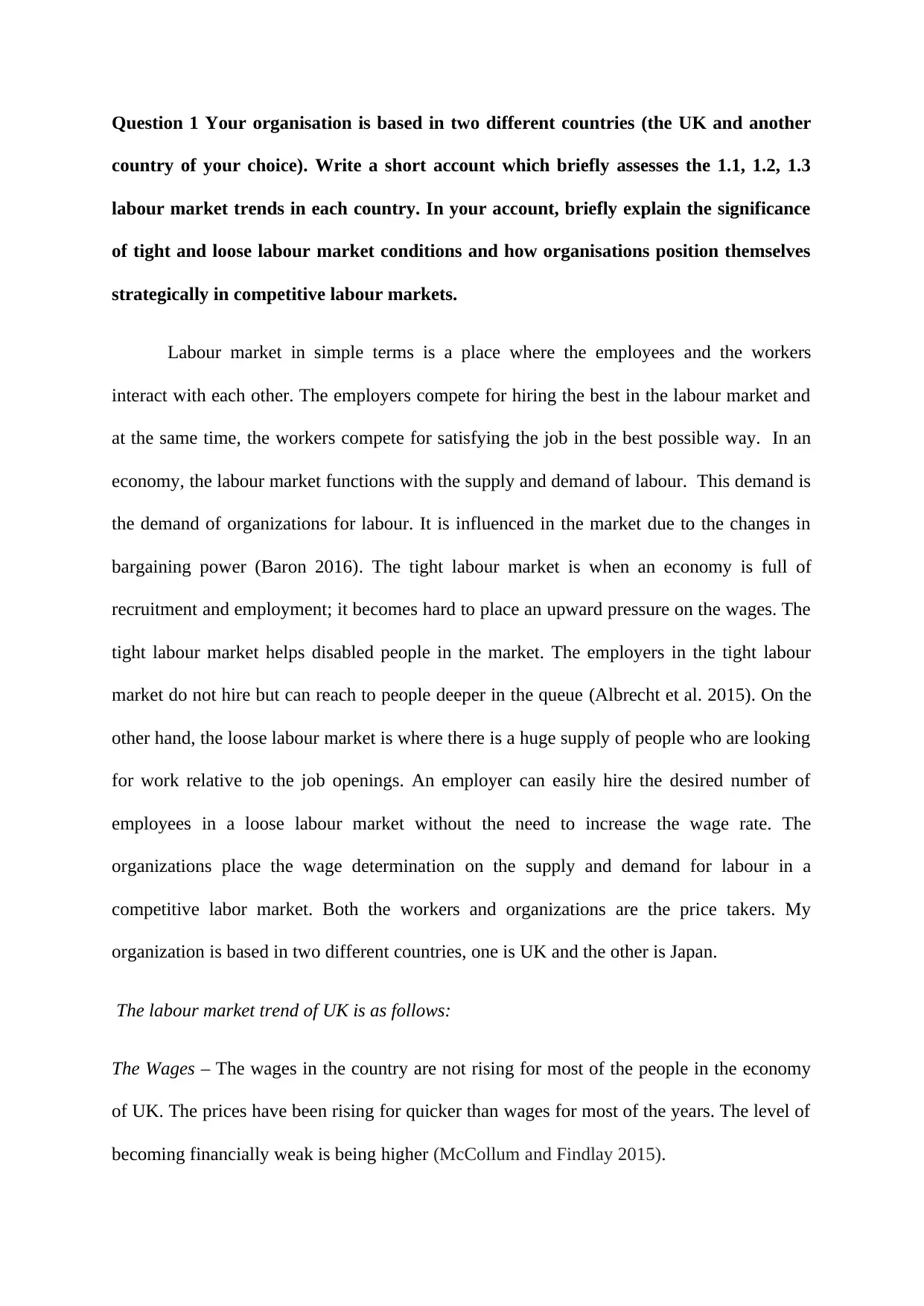
Question 1 Your organisation is based in two different countries (the UK and another
country of your choice). Write a short account which briefly assesses the 1.1, 1.2, 1.3
labour market trends in each country. In your account, briefly explain the significance
of tight and loose labour market conditions and how organisations position themselves
strategically in competitive labour markets.
Labour market in simple terms is a place where the employees and the workers
interact with each other. The employers compete for hiring the best in the labour market and
at the same time, the workers compete for satisfying the job in the best possible way. In an
economy, the labour market functions with the supply and demand of labour. This demand is
the demand of organizations for labour. It is influenced in the market due to the changes in
bargaining power (Baron 2016). The tight labour market is when an economy is full of
recruitment and employment; it becomes hard to place an upward pressure on the wages. The
tight labour market helps disabled people in the market. The employers in the tight labour
market do not hire but can reach to people deeper in the queue (Albrecht et al. 2015). On the
other hand, the loose labour market is where there is a huge supply of people who are looking
for work relative to the job openings. An employer can easily hire the desired number of
employees in a loose labour market without the need to increase the wage rate. The
organizations place the wage determination on the supply and demand for labour in a
competitive labor market. Both the workers and organizations are the price takers. My
organization is based in two different countries, one is UK and the other is Japan.
The labour market trend of UK is as follows:
The Wages – The wages in the country are not rising for most of the people in the economy
of UK. The prices have been rising for quicker than wages for most of the years. The level of
becoming financially weak is being higher (McCollum and Findlay 2015).
country of your choice). Write a short account which briefly assesses the 1.1, 1.2, 1.3
labour market trends in each country. In your account, briefly explain the significance
of tight and loose labour market conditions and how organisations position themselves
strategically in competitive labour markets.
Labour market in simple terms is a place where the employees and the workers
interact with each other. The employers compete for hiring the best in the labour market and
at the same time, the workers compete for satisfying the job in the best possible way. In an
economy, the labour market functions with the supply and demand of labour. This demand is
the demand of organizations for labour. It is influenced in the market due to the changes in
bargaining power (Baron 2016). The tight labour market is when an economy is full of
recruitment and employment; it becomes hard to place an upward pressure on the wages. The
tight labour market helps disabled people in the market. The employers in the tight labour
market do not hire but can reach to people deeper in the queue (Albrecht et al. 2015). On the
other hand, the loose labour market is where there is a huge supply of people who are looking
for work relative to the job openings. An employer can easily hire the desired number of
employees in a loose labour market without the need to increase the wage rate. The
organizations place the wage determination on the supply and demand for labour in a
competitive labor market. Both the workers and organizations are the price takers. My
organization is based in two different countries, one is UK and the other is Japan.
The labour market trend of UK is as follows:
The Wages – The wages in the country are not rising for most of the people in the economy
of UK. The prices have been rising for quicker than wages for most of the years. The level of
becoming financially weak is being higher (McCollum and Findlay 2015).
Paraphrase This Document
Need a fresh take? Get an instant paraphrase of this document with our AI Paraphraser
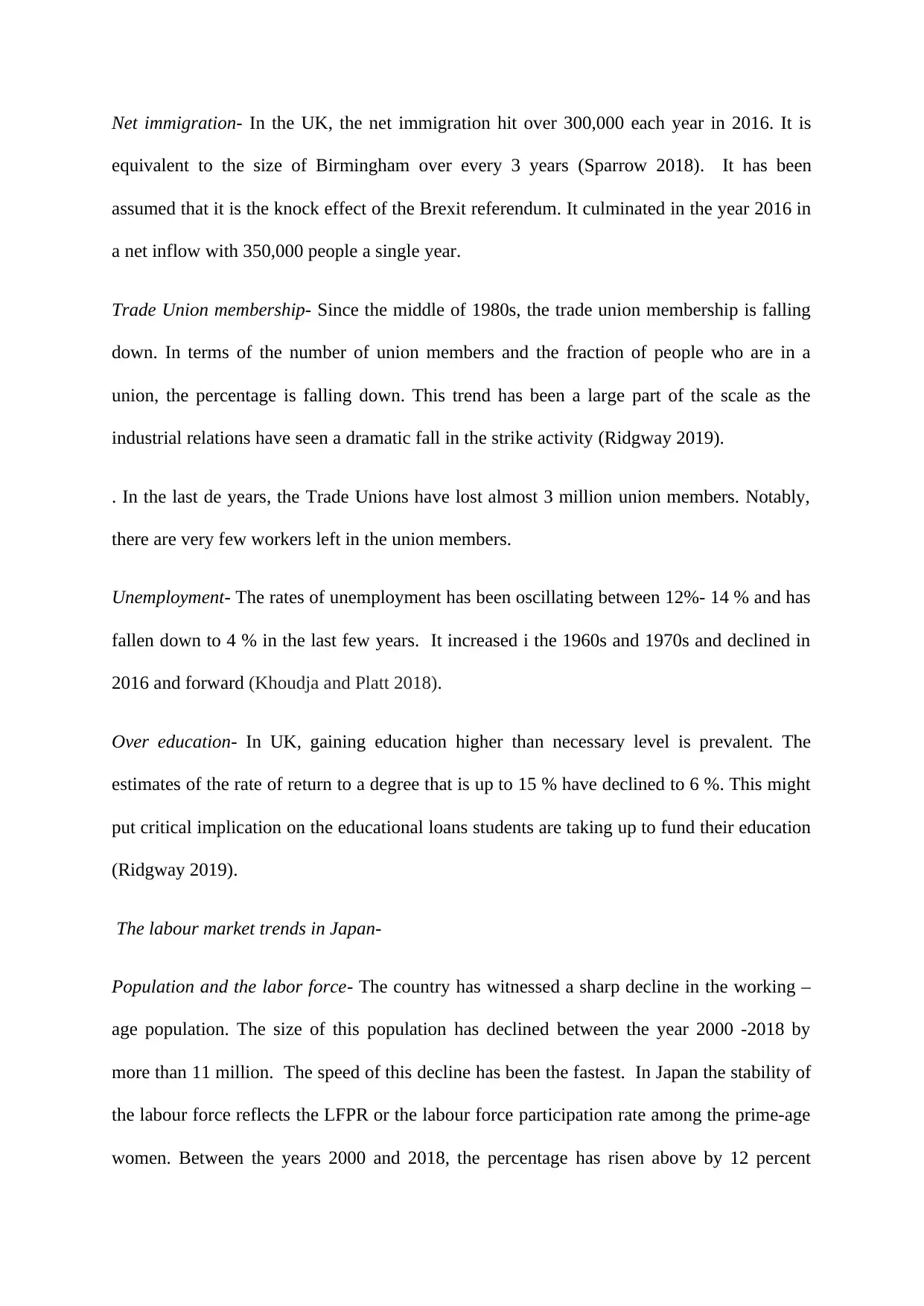
Net immigration- In the UK, the net immigration hit over 300,000 each year in 2016. It is
equivalent to the size of Birmingham over every 3 years (Sparrow 2018). It has been
assumed that it is the knock effect of the Brexit referendum. It culminated in the year 2016 in
a net inflow with 350,000 people a single year.
Trade Union membership- Since the middle of 1980s, the trade union membership is falling
down. In terms of the number of union members and the fraction of people who are in a
union, the percentage is falling down. This trend has been a large part of the scale as the
industrial relations have seen a dramatic fall in the strike activity (Ridgway 2019).
. In the last de years, the Trade Unions have lost almost 3 million union members. Notably,
there are very few workers left in the union members.
Unemployment- The rates of unemployment has been oscillating between 12%- 14 % and has
fallen down to 4 % in the last few years. It increased i the 1960s and 1970s and declined in
2016 and forward (Khoudja and Platt 2018).
Over education- In UK, gaining education higher than necessary level is prevalent. The
estimates of the rate of return to a degree that is up to 15 % have declined to 6 %. This might
put critical implication on the educational loans students are taking up to fund their education
(Ridgway 2019).
The labour market trends in Japan-
Population and the labor force- The country has witnessed a sharp decline in the working –
age population. The size of this population has declined between the year 2000 -2018 by
more than 11 million. The speed of this decline has been the fastest. In Japan the stability of
the labour force reflects the LFPR or the labour force participation rate among the prime-age
women. Between the years 2000 and 2018, the percentage has risen above by 12 percent
equivalent to the size of Birmingham over every 3 years (Sparrow 2018). It has been
assumed that it is the knock effect of the Brexit referendum. It culminated in the year 2016 in
a net inflow with 350,000 people a single year.
Trade Union membership- Since the middle of 1980s, the trade union membership is falling
down. In terms of the number of union members and the fraction of people who are in a
union, the percentage is falling down. This trend has been a large part of the scale as the
industrial relations have seen a dramatic fall in the strike activity (Ridgway 2019).
. In the last de years, the Trade Unions have lost almost 3 million union members. Notably,
there are very few workers left in the union members.
Unemployment- The rates of unemployment has been oscillating between 12%- 14 % and has
fallen down to 4 % in the last few years. It increased i the 1960s and 1970s and declined in
2016 and forward (Khoudja and Platt 2018).
Over education- In UK, gaining education higher than necessary level is prevalent. The
estimates of the rate of return to a degree that is up to 15 % have declined to 6 %. This might
put critical implication on the educational loans students are taking up to fund their education
(Ridgway 2019).
The labour market trends in Japan-
Population and the labor force- The country has witnessed a sharp decline in the working –
age population. The size of this population has declined between the year 2000 -2018 by
more than 11 million. The speed of this decline has been the fastest. In Japan the stability of
the labour force reflects the LFPR or the labour force participation rate among the prime-age
women. Between the years 2000 and 2018, the percentage has risen above by 12 percent
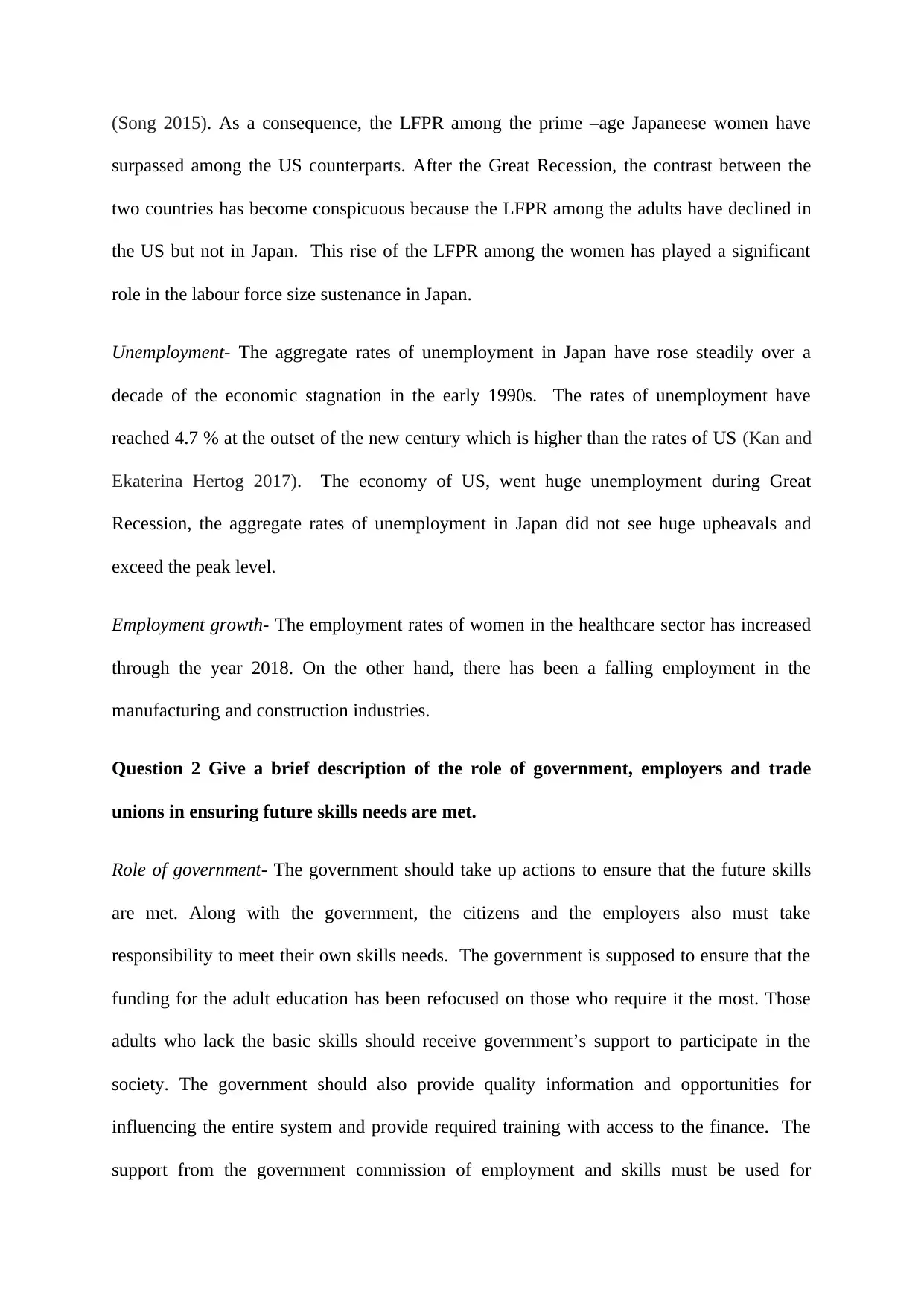
(Song 2015). As a consequence, the LFPR among the prime –age Japaneese women have
surpassed among the US counterparts. After the Great Recession, the contrast between the
two countries has become conspicuous because the LFPR among the adults have declined in
the US but not in Japan. This rise of the LFPR among the women has played a significant
role in the labour force size sustenance in Japan.
Unemployment- The aggregate rates of unemployment in Japan have rose steadily over a
decade of the economic stagnation in the early 1990s. The rates of unemployment have
reached 4.7 % at the outset of the new century which is higher than the rates of US (Kan and
Ekaterina Hertog 2017). The economy of US, went huge unemployment during Great
Recession, the aggregate rates of unemployment in Japan did not see huge upheavals and
exceed the peak level.
Employment growth- The employment rates of women in the healthcare sector has increased
through the year 2018. On the other hand, there has been a falling employment in the
manufacturing and construction industries.
Question 2 Give a brief description of the role of government, employers and trade
unions in ensuring future skills needs are met.
Role of government- The government should take up actions to ensure that the future skills
are met. Along with the government, the citizens and the employers also must take
responsibility to meet their own skills needs. The government is supposed to ensure that the
funding for the adult education has been refocused on those who require it the most. Those
adults who lack the basic skills should receive government’s support to participate in the
society. The government should also provide quality information and opportunities for
influencing the entire system and provide required training with access to the finance. The
support from the government commission of employment and skills must be used for
surpassed among the US counterparts. After the Great Recession, the contrast between the
two countries has become conspicuous because the LFPR among the adults have declined in
the US but not in Japan. This rise of the LFPR among the women has played a significant
role in the labour force size sustenance in Japan.
Unemployment- The aggregate rates of unemployment in Japan have rose steadily over a
decade of the economic stagnation in the early 1990s. The rates of unemployment have
reached 4.7 % at the outset of the new century which is higher than the rates of US (Kan and
Ekaterina Hertog 2017). The economy of US, went huge unemployment during Great
Recession, the aggregate rates of unemployment in Japan did not see huge upheavals and
exceed the peak level.
Employment growth- The employment rates of women in the healthcare sector has increased
through the year 2018. On the other hand, there has been a falling employment in the
manufacturing and construction industries.
Question 2 Give a brief description of the role of government, employers and trade
unions in ensuring future skills needs are met.
Role of government- The government should take up actions to ensure that the future skills
are met. Along with the government, the citizens and the employers also must take
responsibility to meet their own skills needs. The government is supposed to ensure that the
funding for the adult education has been refocused on those who require it the most. Those
adults who lack the basic skills should receive government’s support to participate in the
society. The government should also provide quality information and opportunities for
influencing the entire system and provide required training with access to the finance. The
support from the government commission of employment and skills must be used for
⊘ This is a preview!⊘
Do you want full access?
Subscribe today to unlock all pages.

Trusted by 1+ million students worldwide
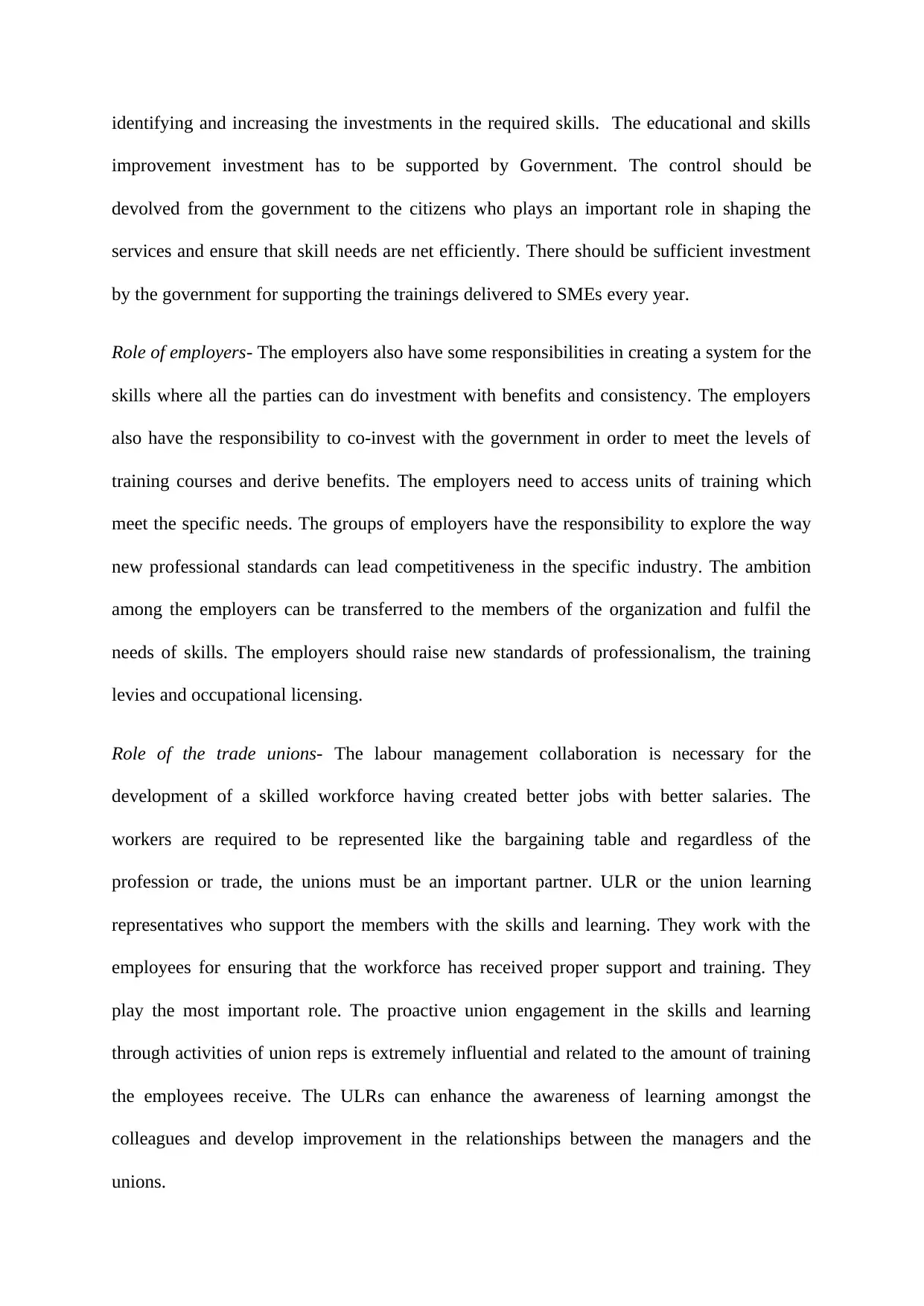
identifying and increasing the investments in the required skills. The educational and skills
improvement investment has to be supported by Government. The control should be
devolved from the government to the citizens who plays an important role in shaping the
services and ensure that skill needs are net efficiently. There should be sufficient investment
by the government for supporting the trainings delivered to SMEs every year.
Role of employers- The employers also have some responsibilities in creating a system for the
skills where all the parties can do investment with benefits and consistency. The employers
also have the responsibility to co-invest with the government in order to meet the levels of
training courses and derive benefits. The employers need to access units of training which
meet the specific needs. The groups of employers have the responsibility to explore the way
new professional standards can lead competitiveness in the specific industry. The ambition
among the employers can be transferred to the members of the organization and fulfil the
needs of skills. The employers should raise new standards of professionalism, the training
levies and occupational licensing.
Role of the trade unions- The labour management collaboration is necessary for the
development of a skilled workforce having created better jobs with better salaries. The
workers are required to be represented like the bargaining table and regardless of the
profession or trade, the unions must be an important partner. ULR or the union learning
representatives who support the members with the skills and learning. They work with the
employees for ensuring that the workforce has received proper support and training. They
play the most important role. The proactive union engagement in the skills and learning
through activities of union reps is extremely influential and related to the amount of training
the employees receive. The ULRs can enhance the awareness of learning amongst the
colleagues and develop improvement in the relationships between the managers and the
unions.
improvement investment has to be supported by Government. The control should be
devolved from the government to the citizens who plays an important role in shaping the
services and ensure that skill needs are net efficiently. There should be sufficient investment
by the government for supporting the trainings delivered to SMEs every year.
Role of employers- The employers also have some responsibilities in creating a system for the
skills where all the parties can do investment with benefits and consistency. The employers
also have the responsibility to co-invest with the government in order to meet the levels of
training courses and derive benefits. The employers need to access units of training which
meet the specific needs. The groups of employers have the responsibility to explore the way
new professional standards can lead competitiveness in the specific industry. The ambition
among the employers can be transferred to the members of the organization and fulfil the
needs of skills. The employers should raise new standards of professionalism, the training
levies and occupational licensing.
Role of the trade unions- The labour management collaboration is necessary for the
development of a skilled workforce having created better jobs with better salaries. The
workers are required to be represented like the bargaining table and regardless of the
profession or trade, the unions must be an important partner. ULR or the union learning
representatives who support the members with the skills and learning. They work with the
employees for ensuring that the workforce has received proper support and training. They
play the most important role. The proactive union engagement in the skills and learning
through activities of union reps is extremely influential and related to the amount of training
the employees receive. The ULRs can enhance the awareness of learning amongst the
colleagues and develop improvement in the relationships between the managers and the
unions.
Paraphrase This Document
Need a fresh take? Get an instant paraphrase of this document with our AI Paraphraser
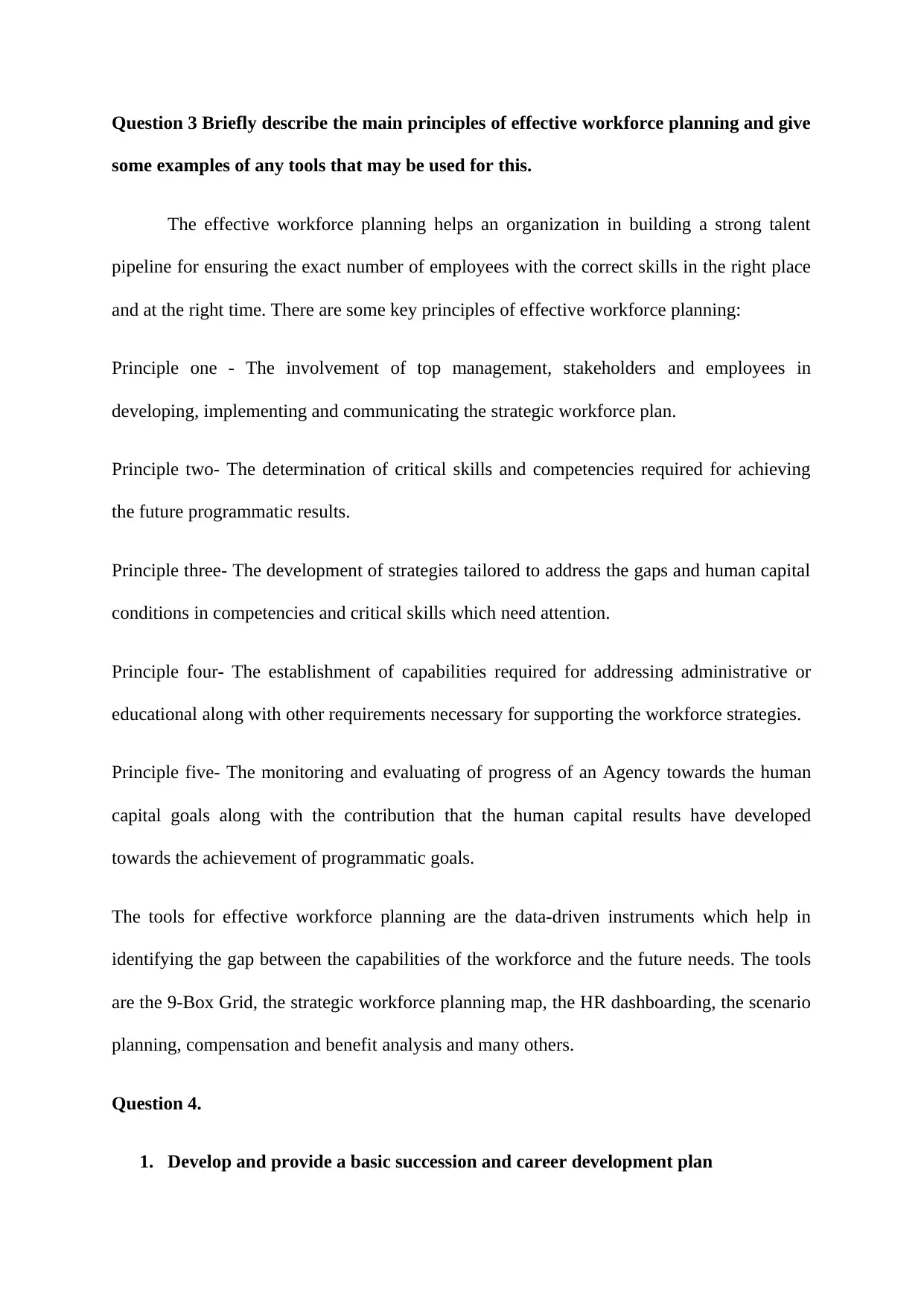
Question 3 Briefly describe the main principles of effective workforce planning and give
some examples of any tools that may be used for this.
The effective workforce planning helps an organization in building a strong talent
pipeline for ensuring the exact number of employees with the correct skills in the right place
and at the right time. There are some key principles of effective workforce planning:
Principle one - The involvement of top management, stakeholders and employees in
developing, implementing and communicating the strategic workforce plan.
Principle two- The determination of critical skills and competencies required for achieving
the future programmatic results.
Principle three- The development of strategies tailored to address the gaps and human capital
conditions in competencies and critical skills which need attention.
Principle four- The establishment of capabilities required for addressing administrative or
educational along with other requirements necessary for supporting the workforce strategies.
Principle five- The monitoring and evaluating of progress of an Agency towards the human
capital goals along with the contribution that the human capital results have developed
towards the achievement of programmatic goals.
The tools for effective workforce planning are the data-driven instruments which help in
identifying the gap between the capabilities of the workforce and the future needs. The tools
are the 9-Box Grid, the strategic workforce planning map, the HR dashboarding, the scenario
planning, compensation and benefit analysis and many others.
Question 4.
1. Develop and provide a basic succession and career development plan
some examples of any tools that may be used for this.
The effective workforce planning helps an organization in building a strong talent
pipeline for ensuring the exact number of employees with the correct skills in the right place
and at the right time. There are some key principles of effective workforce planning:
Principle one - The involvement of top management, stakeholders and employees in
developing, implementing and communicating the strategic workforce plan.
Principle two- The determination of critical skills and competencies required for achieving
the future programmatic results.
Principle three- The development of strategies tailored to address the gaps and human capital
conditions in competencies and critical skills which need attention.
Principle four- The establishment of capabilities required for addressing administrative or
educational along with other requirements necessary for supporting the workforce strategies.
Principle five- The monitoring and evaluating of progress of an Agency towards the human
capital goals along with the contribution that the human capital results have developed
towards the achievement of programmatic goals.
The tools for effective workforce planning are the data-driven instruments which help in
identifying the gap between the capabilities of the workforce and the future needs. The tools
are the 9-Box Grid, the strategic workforce planning map, the HR dashboarding, the scenario
planning, compensation and benefit analysis and many others.
Question 4.
1. Develop and provide a basic succession and career development plan
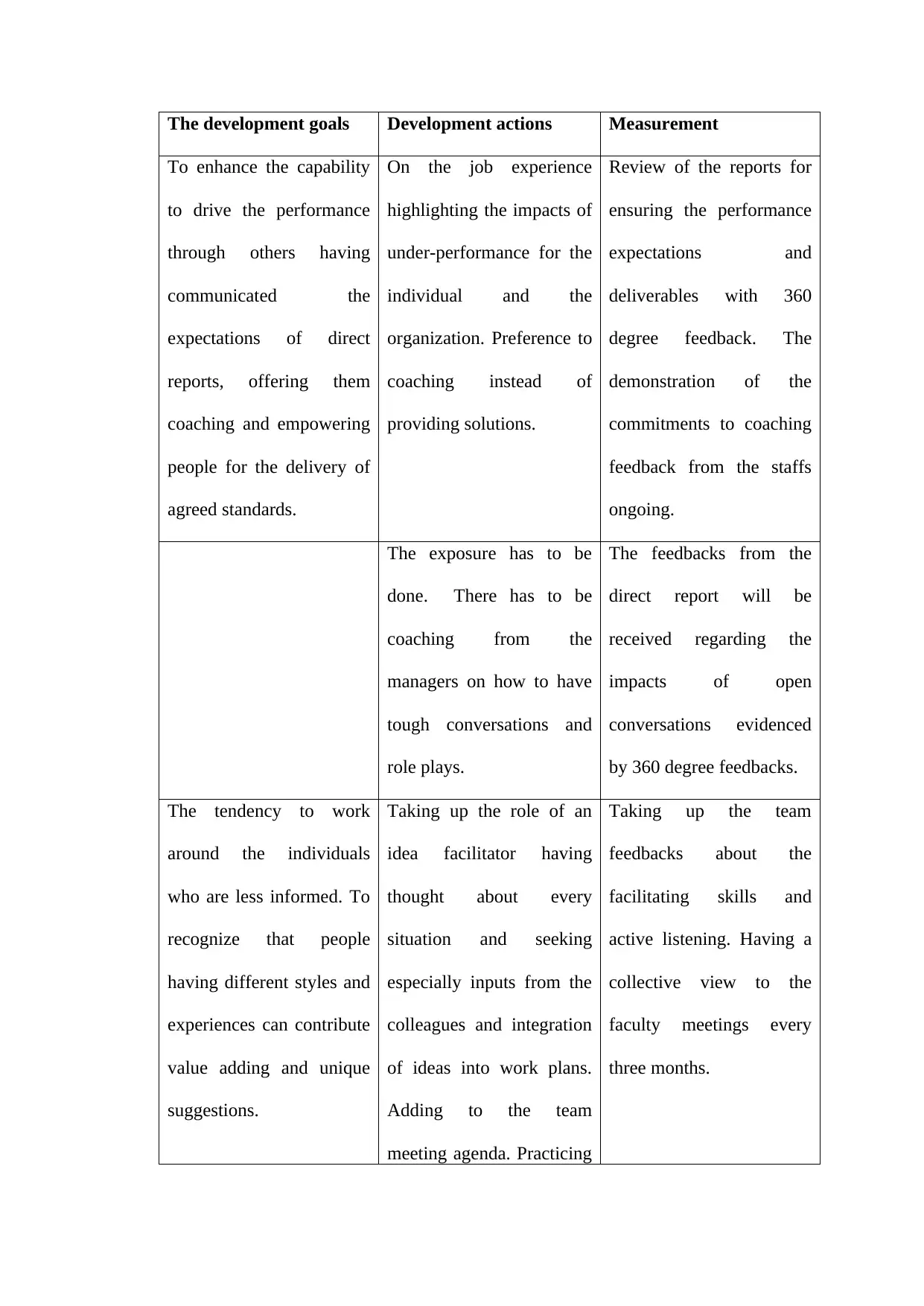
The development goals Development actions Measurement
To enhance the capability
to drive the performance
through others having
communicated the
expectations of direct
reports, offering them
coaching and empowering
people for the delivery of
agreed standards.
On the job experience
highlighting the impacts of
under-performance for the
individual and the
organization. Preference to
coaching instead of
providing solutions.
Review of the reports for
ensuring the performance
expectations and
deliverables with 360
degree feedback. The
demonstration of the
commitments to coaching
feedback from the staffs
ongoing.
The exposure has to be
done. There has to be
coaching from the
managers on how to have
tough conversations and
role plays.
The feedbacks from the
direct report will be
received regarding the
impacts of open
conversations evidenced
by 360 degree feedbacks.
The tendency to work
around the individuals
who are less informed. To
recognize that people
having different styles and
experiences can contribute
value adding and unique
suggestions.
Taking up the role of an
idea facilitator having
thought about every
situation and seeking
especially inputs from the
colleagues and integration
of ideas into work plans.
Adding to the team
meeting agenda. Practicing
Taking up the team
feedbacks about the
facilitating skills and
active listening. Having a
collective view to the
faculty meetings every
three months.
To enhance the capability
to drive the performance
through others having
communicated the
expectations of direct
reports, offering them
coaching and empowering
people for the delivery of
agreed standards.
On the job experience
highlighting the impacts of
under-performance for the
individual and the
organization. Preference to
coaching instead of
providing solutions.
Review of the reports for
ensuring the performance
expectations and
deliverables with 360
degree feedback. The
demonstration of the
commitments to coaching
feedback from the staffs
ongoing.
The exposure has to be
done. There has to be
coaching from the
managers on how to have
tough conversations and
role plays.
The feedbacks from the
direct report will be
received regarding the
impacts of open
conversations evidenced
by 360 degree feedbacks.
The tendency to work
around the individuals
who are less informed. To
recognize that people
having different styles and
experiences can contribute
value adding and unique
suggestions.
Taking up the role of an
idea facilitator having
thought about every
situation and seeking
especially inputs from the
colleagues and integration
of ideas into work plans.
Adding to the team
meeting agenda. Practicing
Taking up the team
feedbacks about the
facilitating skills and
active listening. Having a
collective view to the
faculty meetings every
three months.
⊘ This is a preview!⊘
Do you want full access?
Subscribe today to unlock all pages.

Trusted by 1+ million students worldwide
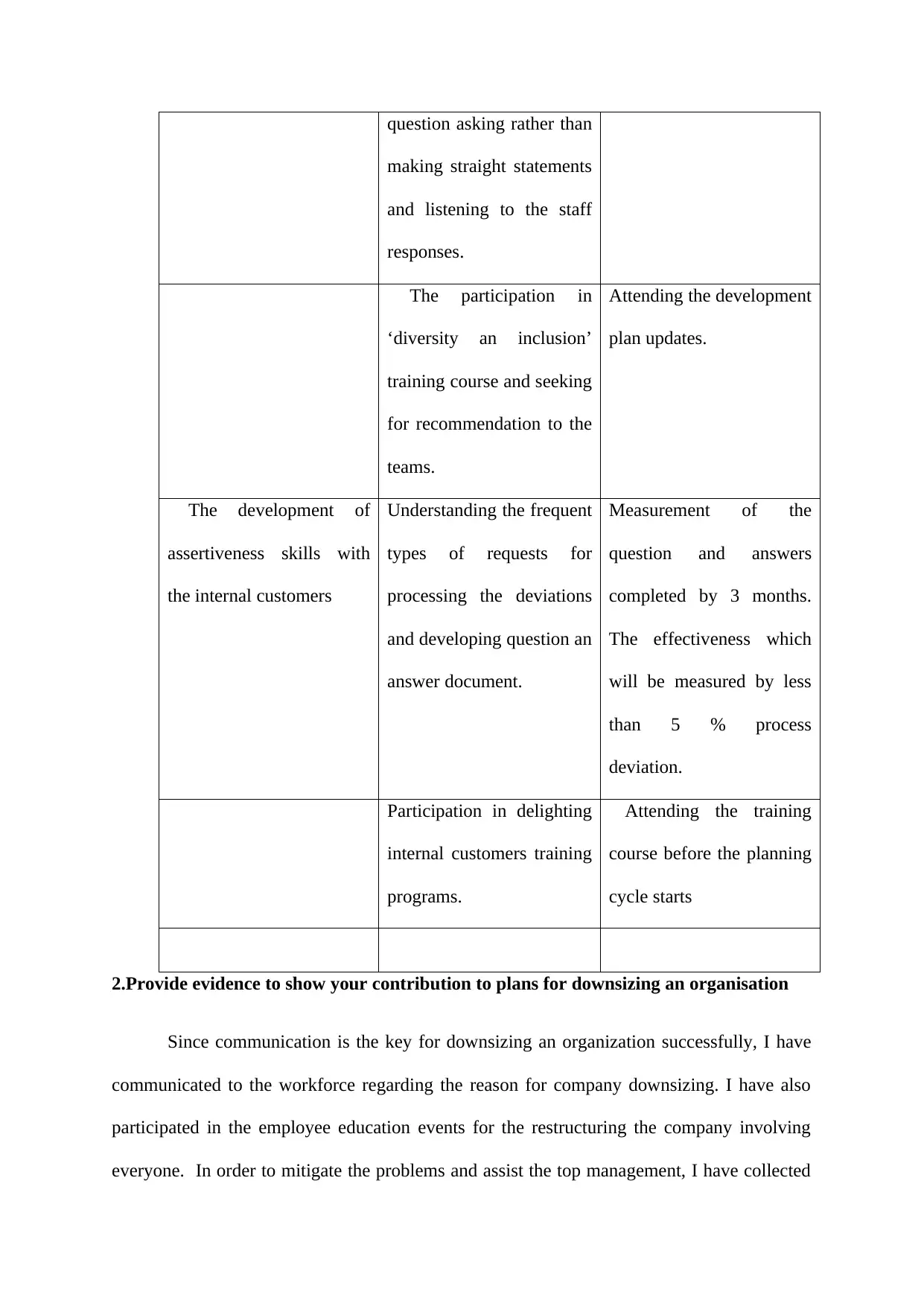
question asking rather than
making straight statements
and listening to the staff
responses.
The participation in
‘diversity an inclusion’
training course and seeking
for recommendation to the
teams.
Attending the development
plan updates.
The development of
assertiveness skills with
the internal customers
Understanding the frequent
types of requests for
processing the deviations
and developing question an
answer document.
Measurement of the
question and answers
completed by 3 months.
The effectiveness which
will be measured by less
than 5 % process
deviation.
Participation in delighting
internal customers training
programs.
Attending the training
course before the planning
cycle starts
2.Provide evidence to show your contribution to plans for downsizing an organisation
Since communication is the key for downsizing an organization successfully, I have
communicated to the workforce regarding the reason for company downsizing. I have also
participated in the employee education events for the restructuring the company involving
everyone. In order to mitigate the problems and assist the top management, I have collected
making straight statements
and listening to the staff
responses.
The participation in
‘diversity an inclusion’
training course and seeking
for recommendation to the
teams.
Attending the development
plan updates.
The development of
assertiveness skills with
the internal customers
Understanding the frequent
types of requests for
processing the deviations
and developing question an
answer document.
Measurement of the
question and answers
completed by 3 months.
The effectiveness which
will be measured by less
than 5 % process
deviation.
Participation in delighting
internal customers training
programs.
Attending the training
course before the planning
cycle starts
2.Provide evidence to show your contribution to plans for downsizing an organisation
Since communication is the key for downsizing an organization successfully, I have
communicated to the workforce regarding the reason for company downsizing. I have also
participated in the employee education events for the restructuring the company involving
everyone. In order to mitigate the problems and assist the top management, I have collected
Paraphrase This Document
Need a fresh take? Get an instant paraphrase of this document with our AI Paraphraser
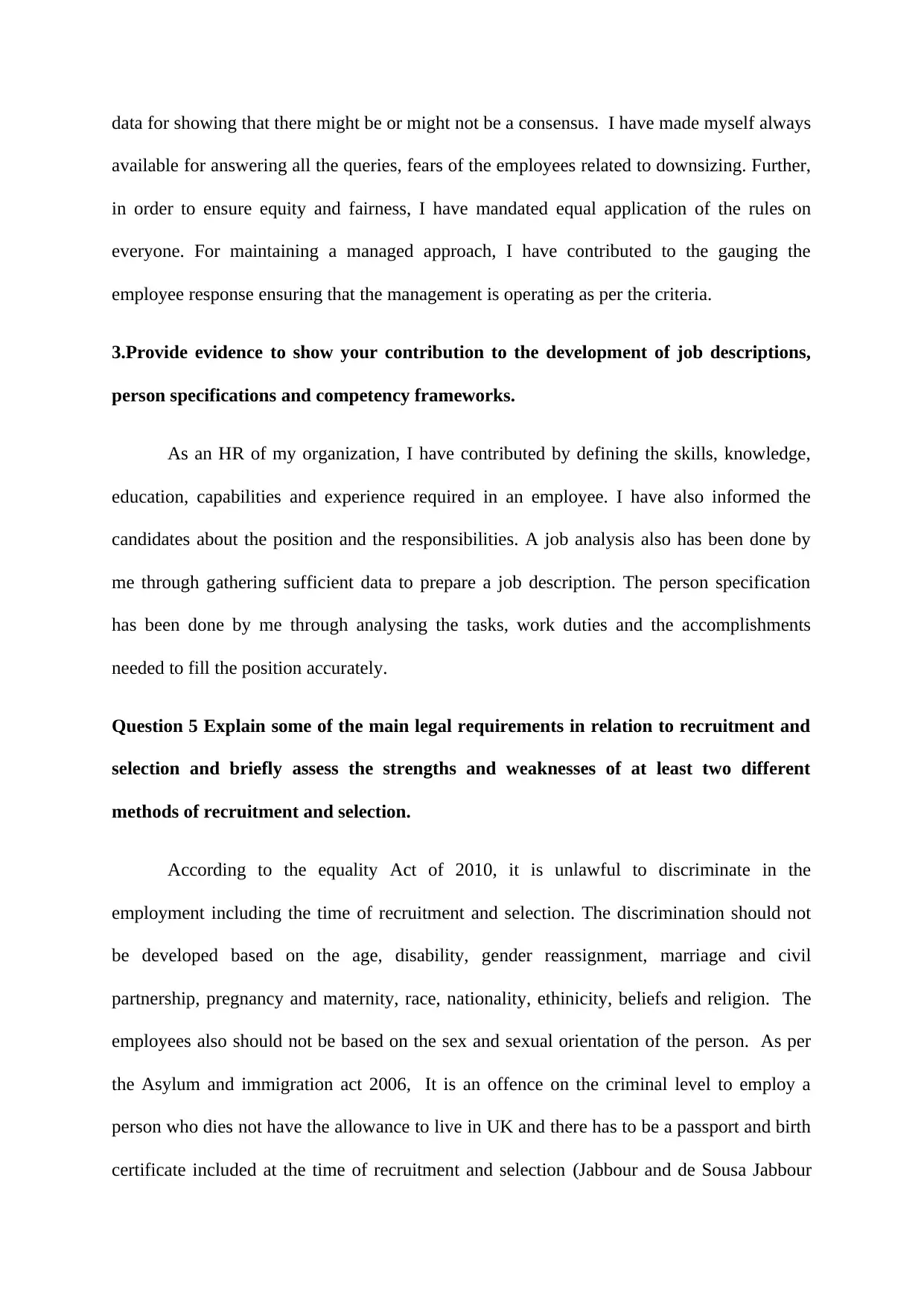
data for showing that there might be or might not be a consensus. I have made myself always
available for answering all the queries, fears of the employees related to downsizing. Further,
in order to ensure equity and fairness, I have mandated equal application of the rules on
everyone. For maintaining a managed approach, I have contributed to the gauging the
employee response ensuring that the management is operating as per the criteria.
3.Provide evidence to show your contribution to the development of job descriptions,
person specifications and competency frameworks.
As an HR of my organization, I have contributed by defining the skills, knowledge,
education, capabilities and experience required in an employee. I have also informed the
candidates about the position and the responsibilities. A job analysis also has been done by
me through gathering sufficient data to prepare a job description. The person specification
has been done by me through analysing the tasks, work duties and the accomplishments
needed to fill the position accurately.
Question 5 Explain some of the main legal requirements in relation to recruitment and
selection and briefly assess the strengths and weaknesses of at least two different
methods of recruitment and selection.
According to the equality Act of 2010, it is unlawful to discriminate in the
employment including the time of recruitment and selection. The discrimination should not
be developed based on the age, disability, gender reassignment, marriage and civil
partnership, pregnancy and maternity, race, nationality, ethinicity, beliefs and religion. The
employees also should not be based on the sex and sexual orientation of the person. As per
the Asylum and immigration act 2006, It is an offence on the criminal level to employ a
person who dies not have the allowance to live in UK and there has to be a passport and birth
certificate included at the time of recruitment and selection (Jabbour and de Sousa Jabbour
available for answering all the queries, fears of the employees related to downsizing. Further,
in order to ensure equity and fairness, I have mandated equal application of the rules on
everyone. For maintaining a managed approach, I have contributed to the gauging the
employee response ensuring that the management is operating as per the criteria.
3.Provide evidence to show your contribution to the development of job descriptions,
person specifications and competency frameworks.
As an HR of my organization, I have contributed by defining the skills, knowledge,
education, capabilities and experience required in an employee. I have also informed the
candidates about the position and the responsibilities. A job analysis also has been done by
me through gathering sufficient data to prepare a job description. The person specification
has been done by me through analysing the tasks, work duties and the accomplishments
needed to fill the position accurately.
Question 5 Explain some of the main legal requirements in relation to recruitment and
selection and briefly assess the strengths and weaknesses of at least two different
methods of recruitment and selection.
According to the equality Act of 2010, it is unlawful to discriminate in the
employment including the time of recruitment and selection. The discrimination should not
be developed based on the age, disability, gender reassignment, marriage and civil
partnership, pregnancy and maternity, race, nationality, ethinicity, beliefs and religion. The
employees also should not be based on the sex and sexual orientation of the person. As per
the Asylum and immigration act 2006, It is an offence on the criminal level to employ a
person who dies not have the allowance to live in UK and there has to be a passport and birth
certificate included at the time of recruitment and selection (Jabbour and de Sousa Jabbour
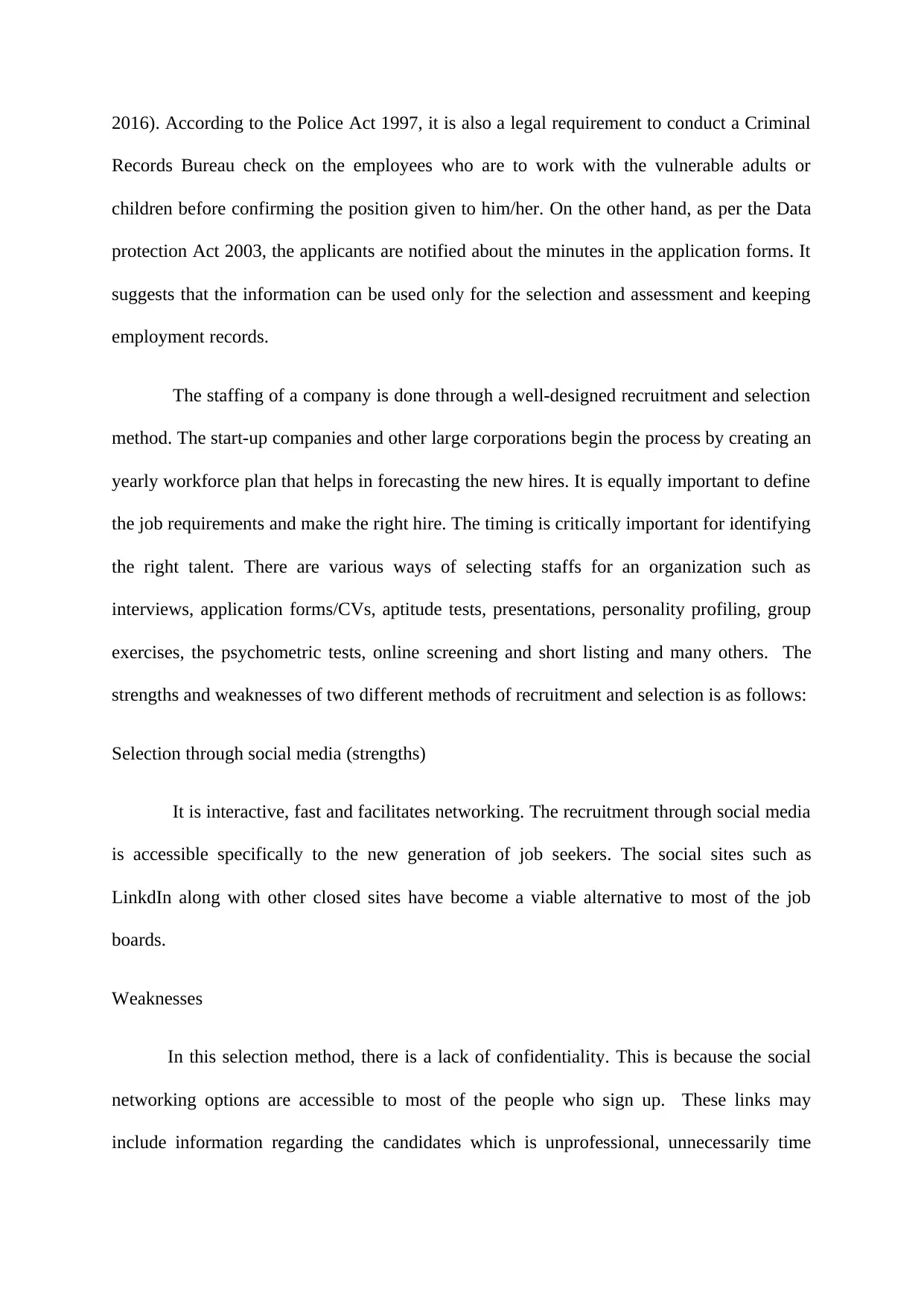
2016). According to the Police Act 1997, it is also a legal requirement to conduct a Criminal
Records Bureau check on the employees who are to work with the vulnerable adults or
children before confirming the position given to him/her. On the other hand, as per the Data
protection Act 2003, the applicants are notified about the minutes in the application forms. It
suggests that the information can be used only for the selection and assessment and keeping
employment records.
The staffing of a company is done through a well-designed recruitment and selection
method. The start-up companies and other large corporations begin the process by creating an
yearly workforce plan that helps in forecasting the new hires. It is equally important to define
the job requirements and make the right hire. The timing is critically important for identifying
the right talent. There are various ways of selecting staffs for an organization such as
interviews, application forms/CVs, aptitude tests, presentations, personality profiling, group
exercises, the psychometric tests, online screening and short listing and many others. The
strengths and weaknesses of two different methods of recruitment and selection is as follows:
Selection through social media (strengths)
It is interactive, fast and facilitates networking. The recruitment through social media
is accessible specifically to the new generation of job seekers. The social sites such as
LinkdIn along with other closed sites have become a viable alternative to most of the job
boards.
Weaknesses
In this selection method, there is a lack of confidentiality. This is because the social
networking options are accessible to most of the people who sign up. These links may
include information regarding the candidates which is unprofessional, unnecessarily time
Records Bureau check on the employees who are to work with the vulnerable adults or
children before confirming the position given to him/her. On the other hand, as per the Data
protection Act 2003, the applicants are notified about the minutes in the application forms. It
suggests that the information can be used only for the selection and assessment and keeping
employment records.
The staffing of a company is done through a well-designed recruitment and selection
method. The start-up companies and other large corporations begin the process by creating an
yearly workforce plan that helps in forecasting the new hires. It is equally important to define
the job requirements and make the right hire. The timing is critically important for identifying
the right talent. There are various ways of selecting staffs for an organization such as
interviews, application forms/CVs, aptitude tests, presentations, personality profiling, group
exercises, the psychometric tests, online screening and short listing and many others. The
strengths and weaknesses of two different methods of recruitment and selection is as follows:
Selection through social media (strengths)
It is interactive, fast and facilitates networking. The recruitment through social media
is accessible specifically to the new generation of job seekers. The social sites such as
LinkdIn along with other closed sites have become a viable alternative to most of the job
boards.
Weaknesses
In this selection method, there is a lack of confidentiality. This is because the social
networking options are accessible to most of the people who sign up. These links may
include information regarding the candidates which is unprofessional, unnecessarily time
⊘ This is a preview!⊘
Do you want full access?
Subscribe today to unlock all pages.

Trusted by 1+ million students worldwide
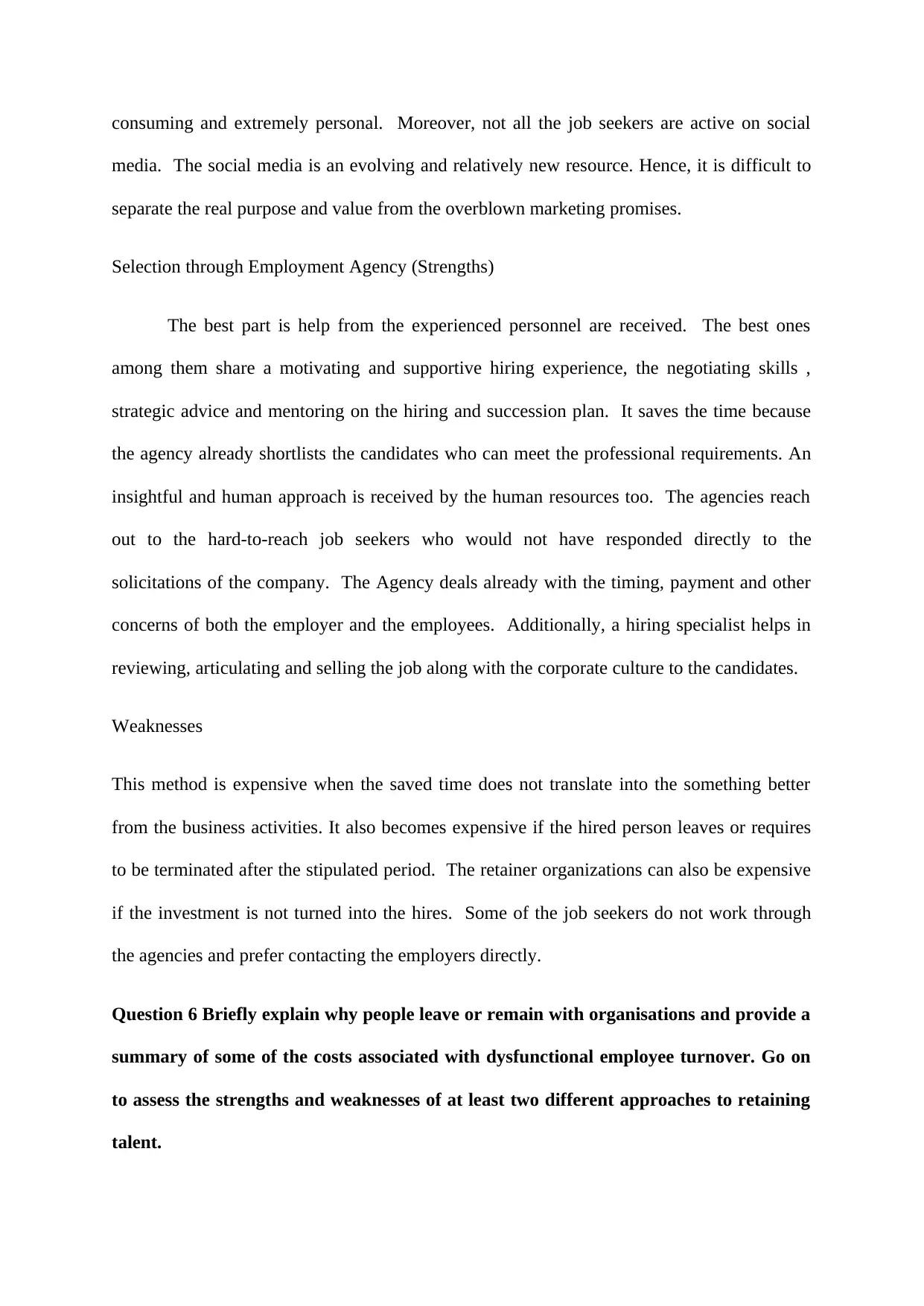
consuming and extremely personal. Moreover, not all the job seekers are active on social
media. The social media is an evolving and relatively new resource. Hence, it is difficult to
separate the real purpose and value from the overblown marketing promises.
Selection through Employment Agency (Strengths)
The best part is help from the experienced personnel are received. The best ones
among them share a motivating and supportive hiring experience, the negotiating skills ,
strategic advice and mentoring on the hiring and succession plan. It saves the time because
the agency already shortlists the candidates who can meet the professional requirements. An
insightful and human approach is received by the human resources too. The agencies reach
out to the hard-to-reach job seekers who would not have responded directly to the
solicitations of the company. The Agency deals already with the timing, payment and other
concerns of both the employer and the employees. Additionally, a hiring specialist helps in
reviewing, articulating and selling the job along with the corporate culture to the candidates.
Weaknesses
This method is expensive when the saved time does not translate into the something better
from the business activities. It also becomes expensive if the hired person leaves or requires
to be terminated after the stipulated period. The retainer organizations can also be expensive
if the investment is not turned into the hires. Some of the job seekers do not work through
the agencies and prefer contacting the employers directly.
Question 6 Briefly explain why people leave or remain with organisations and provide a
summary of some of the costs associated with dysfunctional employee turnover. Go on
to assess the strengths and weaknesses of at least two different approaches to retaining
talent.
media. The social media is an evolving and relatively new resource. Hence, it is difficult to
separate the real purpose and value from the overblown marketing promises.
Selection through Employment Agency (Strengths)
The best part is help from the experienced personnel are received. The best ones
among them share a motivating and supportive hiring experience, the negotiating skills ,
strategic advice and mentoring on the hiring and succession plan. It saves the time because
the agency already shortlists the candidates who can meet the professional requirements. An
insightful and human approach is received by the human resources too. The agencies reach
out to the hard-to-reach job seekers who would not have responded directly to the
solicitations of the company. The Agency deals already with the timing, payment and other
concerns of both the employer and the employees. Additionally, a hiring specialist helps in
reviewing, articulating and selling the job along with the corporate culture to the candidates.
Weaknesses
This method is expensive when the saved time does not translate into the something better
from the business activities. It also becomes expensive if the hired person leaves or requires
to be terminated after the stipulated period. The retainer organizations can also be expensive
if the investment is not turned into the hires. Some of the job seekers do not work through
the agencies and prefer contacting the employers directly.
Question 6 Briefly explain why people leave or remain with organisations and provide a
summary of some of the costs associated with dysfunctional employee turnover. Go on
to assess the strengths and weaknesses of at least two different approaches to retaining
talent.
Paraphrase This Document
Need a fresh take? Get an instant paraphrase of this document with our AI Paraphraser
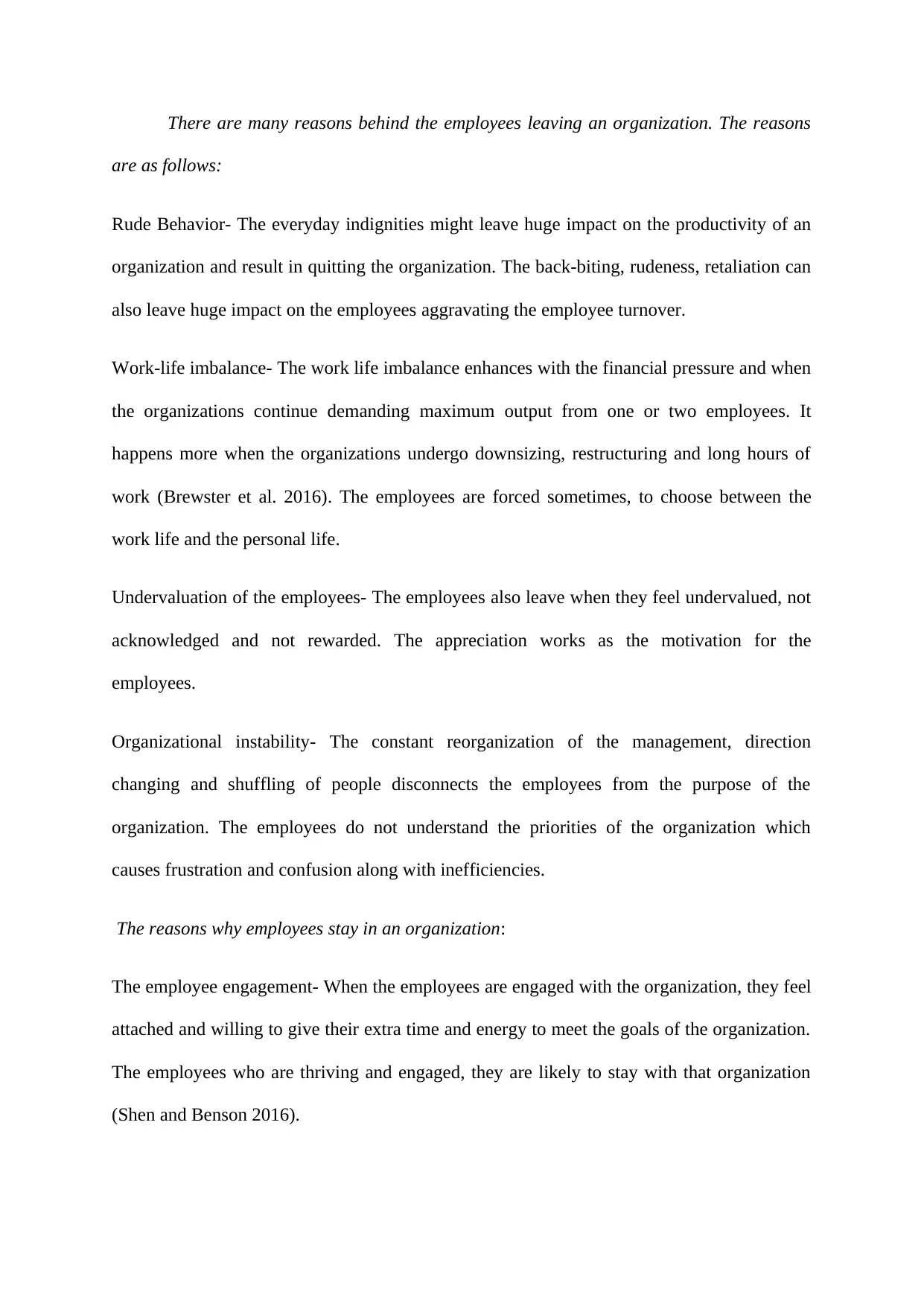
There are many reasons behind the employees leaving an organization. The reasons
are as follows:
Rude Behavior- The everyday indignities might leave huge impact on the productivity of an
organization and result in quitting the organization. The back-biting, rudeness, retaliation can
also leave huge impact on the employees aggravating the employee turnover.
Work-life imbalance- The work life imbalance enhances with the financial pressure and when
the organizations continue demanding maximum output from one or two employees. It
happens more when the organizations undergo downsizing, restructuring and long hours of
work (Brewster et al. 2016). The employees are forced sometimes, to choose between the
work life and the personal life.
Undervaluation of the employees- The employees also leave when they feel undervalued, not
acknowledged and not rewarded. The appreciation works as the motivation for the
employees.
Organizational instability- The constant reorganization of the management, direction
changing and shuffling of people disconnects the employees from the purpose of the
organization. The employees do not understand the priorities of the organization which
causes frustration and confusion along with inefficiencies.
The reasons why employees stay in an organization:
The employee engagement- When the employees are engaged with the organization, they feel
attached and willing to give their extra time and energy to meet the goals of the organization.
The employees who are thriving and engaged, they are likely to stay with that organization
(Shen and Benson 2016).
are as follows:
Rude Behavior- The everyday indignities might leave huge impact on the productivity of an
organization and result in quitting the organization. The back-biting, rudeness, retaliation can
also leave huge impact on the employees aggravating the employee turnover.
Work-life imbalance- The work life imbalance enhances with the financial pressure and when
the organizations continue demanding maximum output from one or two employees. It
happens more when the organizations undergo downsizing, restructuring and long hours of
work (Brewster et al. 2016). The employees are forced sometimes, to choose between the
work life and the personal life.
Undervaluation of the employees- The employees also leave when they feel undervalued, not
acknowledged and not rewarded. The appreciation works as the motivation for the
employees.
Organizational instability- The constant reorganization of the management, direction
changing and shuffling of people disconnects the employees from the purpose of the
organization. The employees do not understand the priorities of the organization which
causes frustration and confusion along with inefficiencies.
The reasons why employees stay in an organization:
The employee engagement- When the employees are engaged with the organization, they feel
attached and willing to give their extra time and energy to meet the goals of the organization.
The employees who are thriving and engaged, they are likely to stay with that organization
(Shen and Benson 2016).
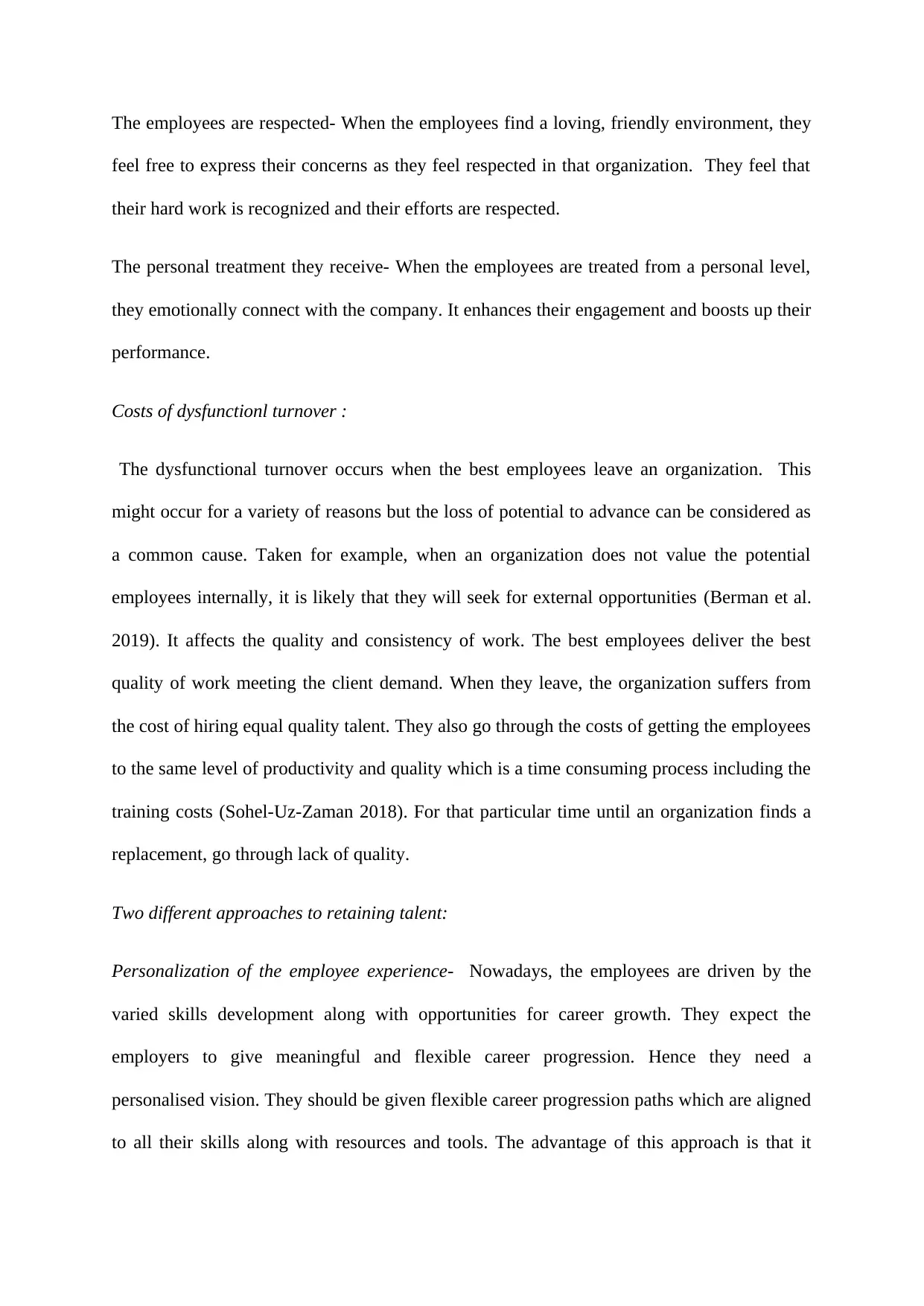
The employees are respected- When the employees find a loving, friendly environment, they
feel free to express their concerns as they feel respected in that organization. They feel that
their hard work is recognized and their efforts are respected.
The personal treatment they receive- When the employees are treated from a personal level,
they emotionally connect with the company. It enhances their engagement and boosts up their
performance.
Costs of dysfunctionl turnover :
The dysfunctional turnover occurs when the best employees leave an organization. This
might occur for a variety of reasons but the loss of potential to advance can be considered as
a common cause. Taken for example, when an organization does not value the potential
employees internally, it is likely that they will seek for external opportunities (Berman et al.
2019). It affects the quality and consistency of work. The best employees deliver the best
quality of work meeting the client demand. When they leave, the organization suffers from
the cost of hiring equal quality talent. They also go through the costs of getting the employees
to the same level of productivity and quality which is a time consuming process including the
training costs (Sohel-Uz-Zaman 2018). For that particular time until an organization finds a
replacement, go through lack of quality.
Two different approaches to retaining talent:
Personalization of the employee experience- Nowadays, the employees are driven by the
varied skills development along with opportunities for career growth. They expect the
employers to give meaningful and flexible career progression. Hence they need a
personalised vision. They should be given flexible career progression paths which are aligned
to all their skills along with resources and tools. The advantage of this approach is that it
feel free to express their concerns as they feel respected in that organization. They feel that
their hard work is recognized and their efforts are respected.
The personal treatment they receive- When the employees are treated from a personal level,
they emotionally connect with the company. It enhances their engagement and boosts up their
performance.
Costs of dysfunctionl turnover :
The dysfunctional turnover occurs when the best employees leave an organization. This
might occur for a variety of reasons but the loss of potential to advance can be considered as
a common cause. Taken for example, when an organization does not value the potential
employees internally, it is likely that they will seek for external opportunities (Berman et al.
2019). It affects the quality and consistency of work. The best employees deliver the best
quality of work meeting the client demand. When they leave, the organization suffers from
the cost of hiring equal quality talent. They also go through the costs of getting the employees
to the same level of productivity and quality which is a time consuming process including the
training costs (Sohel-Uz-Zaman 2018). For that particular time until an organization finds a
replacement, go through lack of quality.
Two different approaches to retaining talent:
Personalization of the employee experience- Nowadays, the employees are driven by the
varied skills development along with opportunities for career growth. They expect the
employers to give meaningful and flexible career progression. Hence they need a
personalised vision. They should be given flexible career progression paths which are aligned
to all their skills along with resources and tools. The advantage of this approach is that it
⊘ This is a preview!⊘
Do you want full access?
Subscribe today to unlock all pages.

Trusted by 1+ million students worldwide
1 out of 17
Related Documents
Your All-in-One AI-Powered Toolkit for Academic Success.
+13062052269
info@desklib.com
Available 24*7 on WhatsApp / Email
![[object Object]](/_next/static/media/star-bottom.7253800d.svg)
Unlock your academic potential
Copyright © 2020–2025 A2Z Services. All Rights Reserved. Developed and managed by ZUCOL.




